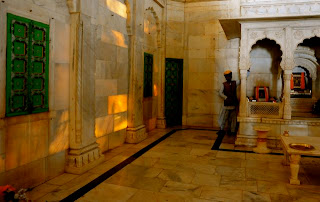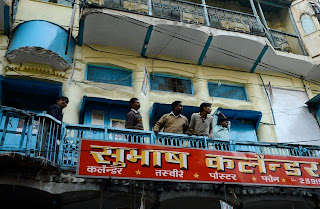Nancy, one of my dearest travel companions, has verbalized an observation for me: The people in India seem not only friendly, but happy, as well. In the old bazaar under the clock tower in Jodhpur, countless small merchants sell their wares and spices, every one of them smiling. They are quick to respond to my waves to them. These people at the old bazaar are the real-life, day-to-day working people who face the realities of life in ways I would not know in any way. They sit most of the day by their property, for example, bracelets or spices, and wait for a buyer. When one does appear, the bargaining begins. At the end of the day, a great many bracelets or spices are packed tightly and carried away. Every once in a while did I see a vendor sitting next to her spread with fewer items at the end of the day. The men in the photo below exemplify part of life in India: They sit around a fire by the side of the street to warm themselves -- and they wave at a passing tourist, smiling.

At the Meherangarh Fort, I noticed the commercialized smiles on the faces of the guards and other staff members; if not for my previous experience with smiling faces, I would not be able to know that behind the trained smiles are people who will feel genuine about feeling friendly at any time, not only when called upon by their job to smile at a tourist.
There were at the Meherrangarh Fort and the Jaswant Thada, musicians who played while small children danced. Perhaps aged four, a little boy danced crudely, without smiling at all, squinting in the hazy sun, following the instructions his father spoke from behind his dilruba (fiddle) as he played. He instructed the boy to turn, to raise his arms, and then to hold out his hand for money from the people watching. At the Jaswant Thada, a young woman, scantly past pubescence, danced with vigor while her father played and her little brother danced. Her little brother danced and followed her direction, every one similar to the direction given to the younger boy at the Meherangarh Fort. Closer to the monument, another boy, much older than the previous two, about ten years old, beat the drum while he sang. Whenever tourists approached, his beat began and his voice carried throughout the grounds. Alone, he did not seem to need instruction, and he sang loudly, clearly, apparently well trained to know when he could rest his hands and voice, and when he should begin his music to entertain the tourists. He garnered many tips, in comparison to the other musicians, during the short time I watched.


We came upon four men who appeared to be soldiers at the fort. They sat crossed-legged in a recessed wall, three with shenai (flutes), and one with drums. In contrast to the other musicians, these men seemed to have made an impromptu decision to find their instruments, sit in the recession of the wall, and jam.

Some of the musicians' shoes are pictured below.


















































